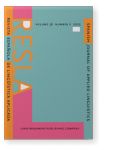Vol. 36:2 (2023) ► pp.615–642
Vol. 36:2 (2023) ► pp.615–642
Influencia de factores contextuales en creencias pedagógicas de los profesores de ELE en China
Una perspectiva ecológica
Las creencias pedagógicas de los profesores cumplen una función clave a la hora de marcar la práctica docente. Así, entender los factores contextuales que influyen en dichas creencias puede ayudar a mejorar y reformar la metodología educativa y elevar su eficacia. Basado en la teoría ecológica de Bronfenbrenner (1979), este estudio expone en diferentes niveles los factores contextuales que influyen sobre las creencias de 20 profesores de español en ocho universidades chinas. Se revela, mediante los datos de entrevista, que dichos factores consisten en cuatro niveles: educación universitaria y experiencia intercultural (microsistema); política escolar, programa curricular y voluntad de los alumnos (mesosistema); entorno socioeconómico (exosistema), y cultura e ideología tradicional (macrosistema), los cuales también interactúan entre sí. El resultado ahonda en el entendimiento sobre la enseñanza del español en China, lo que genera conocimientos sobre la educación de otros idiomas distintos al inglés en el contexto asiático.
Article outline
- 1.Introducción
- 2.Estudios previos
- 2.1Definición de las creencias de los profesores y la influencia del contexto
- 2.2La teoría ecológica de Bronfenbrenner
- 2.3La ELE en el contexto chino
- 3.Diseño del estudio
- 3.1Contexto del estudio
- 3.2Participantes
- 3.3Metodología y análisis de los datos
- 4.Resultados
- 4.1Microsistema
- 4.2Mesosistema
- 4.3Exosistema
- 4.4Macrosistema
- 5.Discusión
- 6.Conclusión
- Notas
-
Referencias
Article language: Spanish
